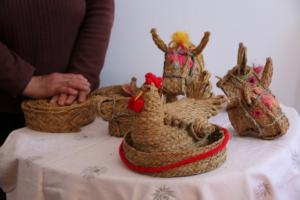Esparto
The use of esparto and palm were, in the past, one of the most important transforming activities in the Algarve.
Mr. João Florêncio, at Desbarato, São Brás de Alportel, started working with palm at the age of 12, inspired by the women of the house (his mother and aunt), who worked with palm. At age, 17 he started working with esparto. He claims that esparto is work for men, given the effort it represents throughout the different stages of the process. The picking is done in the immediate vicinity, by himself. In order for it to have the ideal resistance and elasticity, esparto grass is picked dry (in summer) and processed raw (without being beaten) – the end result is a more perfect plait, less split. He started by creating utilitarian pieces (sacks, carrycots or baskets) that, with the advent of plastic, were no longer produced. Since then he has dedicated himself to decorative pieces for tourist purposes.
In Alte, for instance, the work of esparto was the main occupation after agriculture, having become an important nucleus of production of this activity. From the 1960s onwards, it became one of the business cards for tourism.
Aldegundes Gomes, a resident of Sítio das Sarnadas, in Alte, is an example of how esparto marked Alte’s identity. Currently, she is the only artisan who works and masters the technique of the esparto confection process in the region. Similarly to João Florêncio, Aldegundes pieces are of a decorative nature, intended for the tourism market.


